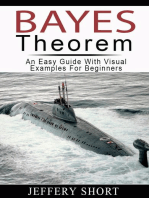0 ratings0% found this document useful (0 votes)
27 viewsNaive Bayes Algorithm
The document discusses Bayesian classifiers which use Bayes' theorem to predict class membership probabilities based on training data. It can learn from large datasets and predict with high accuracy and speed. An example is given of using a Bayesian classifier to predict whether to play tennis based on weather conditions.
Uploaded by
Khushi PachauriCopyright
© © All Rights Reserved
We take content rights seriously. If you suspect this is your content, claim it here.
Available Formats
Download as PDF, TXT or read online on Scribd
0 ratings0% found this document useful (0 votes)
27 viewsNaive Bayes Algorithm
The document discusses Bayesian classifiers which use Bayes' theorem to predict class membership probabilities based on training data. It can learn from large datasets and predict with high accuracy and speed. An example is given of using a Bayesian classifier to predict whether to play tennis based on weather conditions.
Uploaded by
Khushi PachauriCopyright
© © All Rights Reserved
We take content rights seriously. If you suspect this is your content, claim it here.
Available Formats
Download as PDF, TXT or read online on Scribd
You are on page 1/ 4
Baysian Classifier:
It is statistical classifier. It can predict class membership
probabilities, such as the probability that a given tuple
belongs to a particular class. This is based on Baye’s (18th-
century British mathematician Thomas Bayes) theorem.
It shows high accuracy and speed when it is applied to a
large database.
COMP20411 Machine Learning 1
Example
• Example: Play Tennis
COMP20411 Machine Learning 2
Example
• Learning Phase
Outlook Play=Yes Play=No Temperature Play=Yes Play=No
Sunny 2/9 3/5 Hot 2/9 2/5
Overcast 4/9 0/5 Mild 4/9 2/5
Rain 3/9 2/5 Cool 3/9 1/5
Humidity Play=Yes Play=No Wind Play=Yes Play=No
High 3/9 4/5 Strong 3/9 3/5
Normal 6/9 1/5 Weak 6/9 2/5
P(Play=Yes) = 9/14 P(Play=No) = 5/14
COMP20411 Machine Learning 3
Example
• Test Phase
– Given a new instance,
x’=(Outlook=Sunny, Temperature=Cool, Humidity=High, Wind=Strong)
– Look up tables
P(Outlook=Sunny|Play=Yes) = 2/9 P(Outlook=Sunny|Play=No) = 3/5
P(Temperature=Cool|Play=Yes) = 3/9 P(Temperature=Cool|Play==No) = 1/5
P(Huminity=High|Play=Yes) = 3/9 P(Huminity=High|Play=No) = 4/5
P(Wind=Strong|Play=Yes) = 3/9 P(Wind=Strong|Play=No) = 3/5
P(Play=Yes) = 9/14 P(Play=No) = 5/14
– MAP rule
P(Yes|x’): [P(Sunny|Yes)P(Cool|Yes)P(High|Yes)P(Strong|Yes)]P(Play=Yes) = 0.0053
P(No|x’): [P(Sunny|No) P(Cool|No)P(High|No)P(Strong|No)]P(Play=No) = 0.0206
Given the fact P(Yes|x’) < P(No|x’), we label x’ to be “No”.
COMP20411 Machine Learning 4
You might also like
- Naïve Bayes Classifier: Dr. Hussain DawoodNo ratings yetNaïve Bayes Classifier: Dr. Hussain Dawood20 pages
- Lecture-7 Classification Using Naive BaysNo ratings yetLecture-7 Classification Using Naive Bays19 pages
- 20210913115710D3708 - Session 09-12 Bayes ClassifierNo ratings yet20210913115710D3708 - Session 09-12 Bayes Classifier30 pages
- Naive Bayes Classifier in Machine Learning - JavatpointNo ratings yetNaive Bayes Classifier in Machine Learning - Javatpoint19 pages
- Week 4 - Classification Alternative TechniquesNo ratings yetWeek 4 - Classification Alternative Techniques87 pages
- Bayesian Classification: Cse 634 Data Mining - Prof. Anita WasilewskaNo ratings yetBayesian Classification: Cse 634 Data Mining - Prof. Anita Wasilewska66 pages
- Predicting The Missing Value by Bayesian Classification: AbstractNo ratings yetPredicting The Missing Value by Bayesian Classification: Abstract5 pages
- ML Unit No.4 Naïve Bayes Classifiers PPT NotesNo ratings yetML Unit No.4 Naïve Bayes Classifiers PPT Notes47 pages
- K - Nearest Neighbours Classifier / RegressorNo ratings yetK - Nearest Neighbours Classifier / Regressor35 pages
- Module - 4 - ECE3047 - Machine LearningNo ratings yetModule - 4 - ECE3047 - Machine Learning81 pages
- Khushi Pachauri: Computer Science UndergraduateNo ratings yetKhushi Pachauri: Computer Science Undergraduate1 page
- Chemistry of Natural Dyes: Resonance April 2012No ratings yetChemistry of Natural Dyes: Resonance April 20129 pages










































































